- 1. Japan: The Beginning of it All
- 2. The basics of Japanese style
-
3.
Japanese Style: Environmental Friendliness Comes First
- 3.1. Partitions
- 3.2. Furniture for Contemplating the Inner World
- 3.3. Engawa or traditional window?
- 3.4. Walls
- 3.5. Wallpaper
- 3.6. Wallpaper made in Japan
- 3.7. Flooring: which covering is better?
- 3.8. Ceiling: form and content
- 3.9. Fabric, creating comfort
- 3.10. Accessories: placing accents
- 3.11. Lighting that emphasizes Eastern flavor
- 4. Interiors of rooms
- 5. Conclusions
Japanese-style apartments offer the guarantee of comfort, tranquility, and harmony in your home. At once exotic and understated, the Japanese style has remained popular for many years and is not limited to residential spaces, but can also be seen in cafes and hotels. This style is based on harmony and unity with nature, self-discovery through understanding the world, and the use of natural materials. For more details on this style, please read on.
Japan: The Beginning of it All
As we delve into the basics of Japanese design, we discover the philosophy of the East, the perception of the world by people living so far from us, their traditions, and mentality. For Eastern people, thoughts and actions are important, but not trivial bustle. All these requirements are reflected in housing decorated in the Japanese style.
Harmony does not require an abundance of furniture and accessories, bright decor, or ostentatious expensive things. Japanese interior design is about the simple beauty of ordinary things, order, and neatness in the arrangement of objects.
Who will like and fit this style? Reflective and calm people who value order in the home and aesthetics of the surrounding interior.
Emergence of the Style
As such, the Japanese style of decorating residential spaces dates back to the distant 16th-17th century. Several centuries later, it remains in demand and popular.
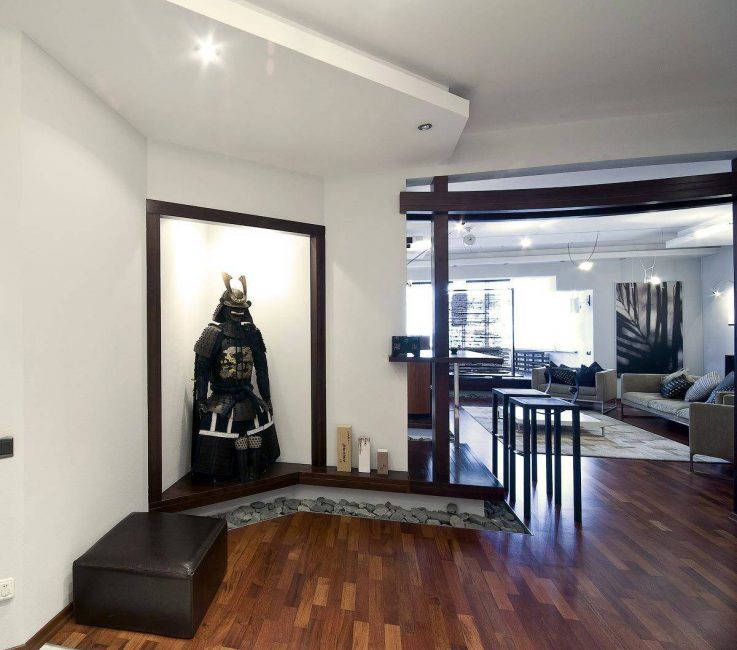
The emergence of the style was influenced by the following factors:
- frequent earthquakes;
- the traditions of the people;
- a small amount of useful minerals;
- Japan’s high population density;
- climate.
As early as the 16th century, Japan began to show a tendency towards arranging homes with taste and in accordance with traditions. Luxury gave way to higher values. The Western approach to apartment layout and design did not take root in the Land of the Rising Sun.
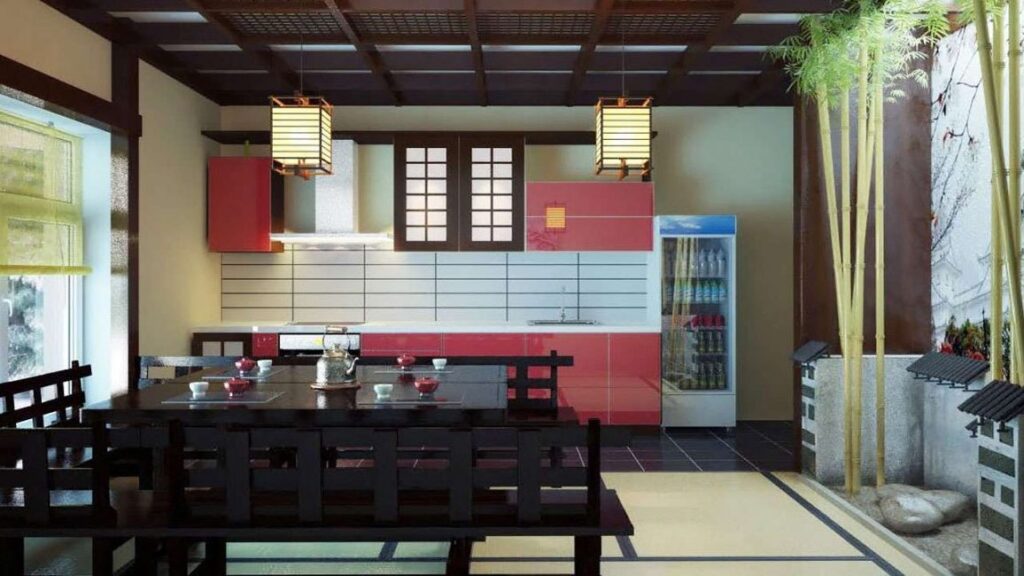
The country’s unique territorial location, frequent earthquakes, and climate have left their mark. In areas with unstable seismological conditions, people often had to rebuild homes after destruction. Easily assembled external wall structures and the absence of internal walls made it relatively easy to rebuild.
Open Layout
Spaciousness should be felt even in a small dwelling. Economical use of free space requires a small amount of furniture, let alone accessories. According to ancient Japanese traditions, there are no ordinary walls or doors between rooms in a home.
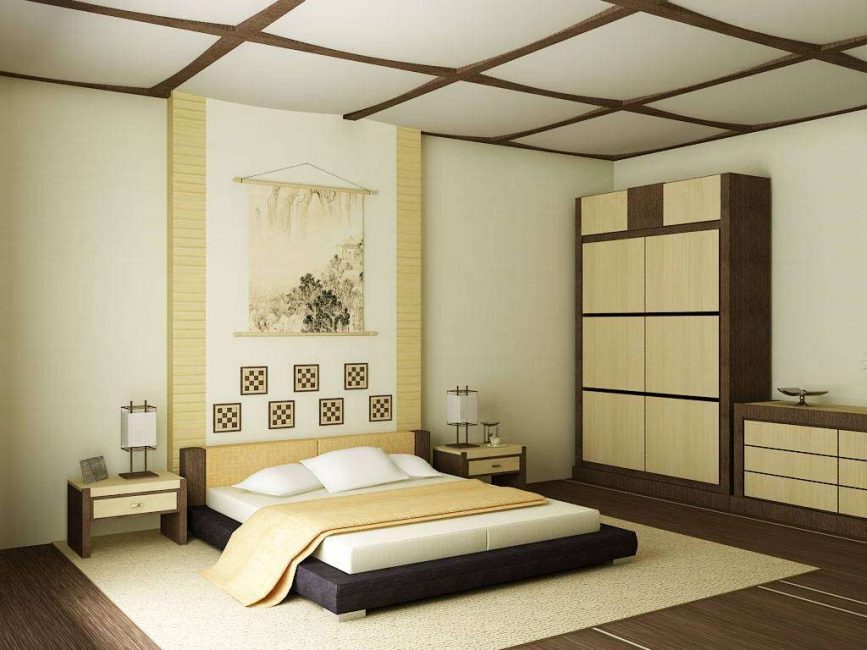
Meanwhile, the zoning is preserved using various techniques:
- screens and other partitions;
- lighting;
- level floors.
Is there any difference in interior design today?
After several centuries, the style of home decoration in the Land of the Rising Sun has undergone some changes.
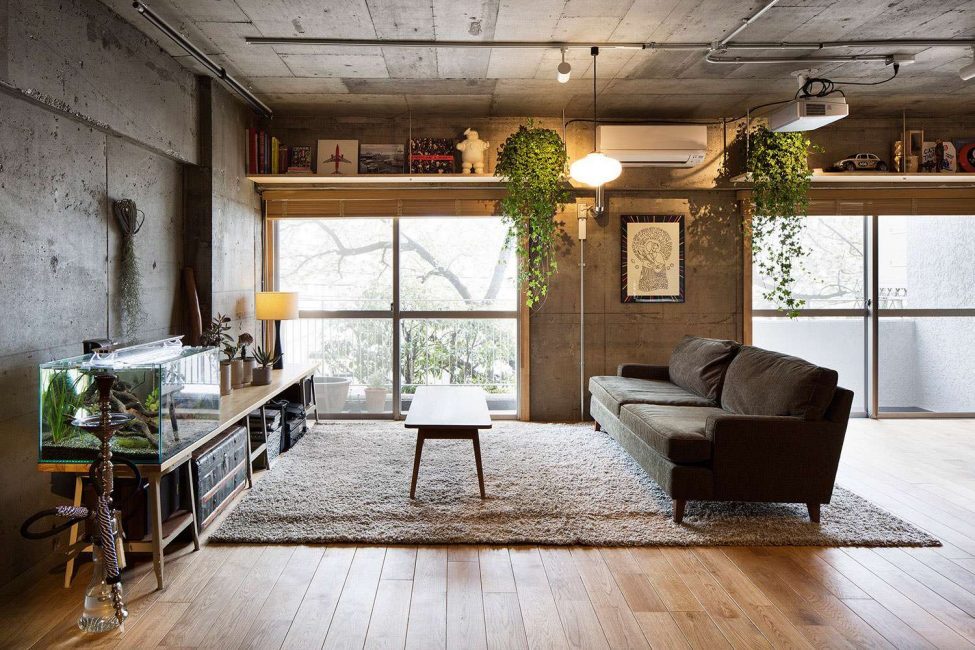
It reflects the events happening in the world:
- technological progress;
- wars, including World War II;
- scientific achievements.
All of this led to new possibilities for design and construction of housing. Concrete, materials that imitate natural stone and wood, became widely used in construction.
However, even the development of science and technology could not change the fundamentals of the style and the desire to be in harmony with nature.
The basics of Japanese style
Today, ethnic style is very popular, and the East, in particular. If you decide to decorate your apartment in Japanese style, it is advisable to follow the basic principles.
Nature
Closeness to nature, respect for it and understanding form the basis for creating a Japanese home. Ideally, large windows and doorways should offer a view of a picturesque garden, fountains, and lawns.
In an urban apartment interior, the principles of unity with nature take the following forms:
- an aquarium with fish;
- bonsai;
- bamboo in flower pots;
- paintings with views of nature
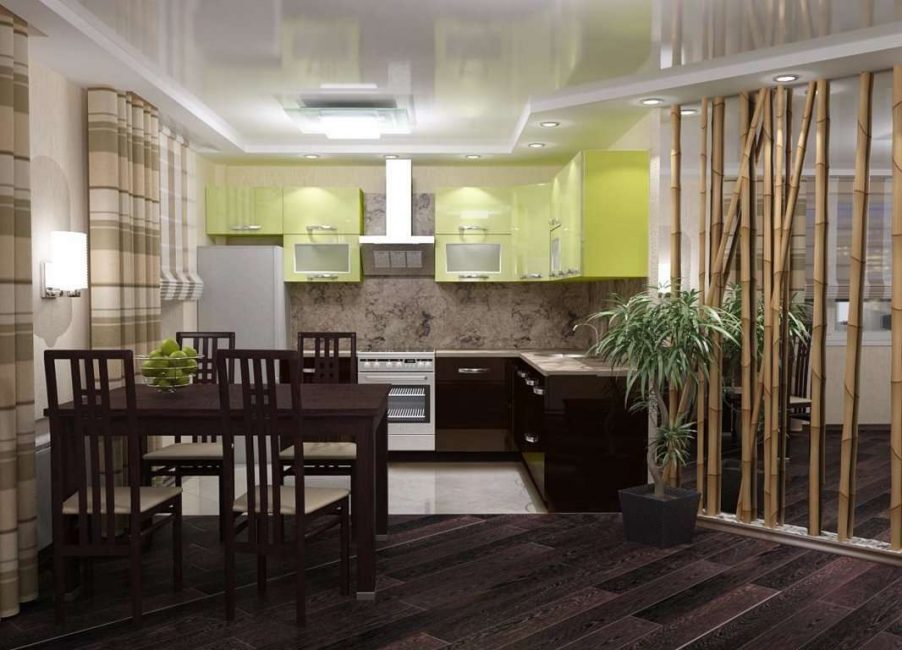
For a stylish country house, you can expand the Japanese style decoration beyond the interior and decorate the backyard in the same way.
Partitions
Division between rooms, separation of personal space in a shared room, and zoning are done using partitions. Wood, rice paper, and bamboo are used for this purpose.
The more free space there is, the better.
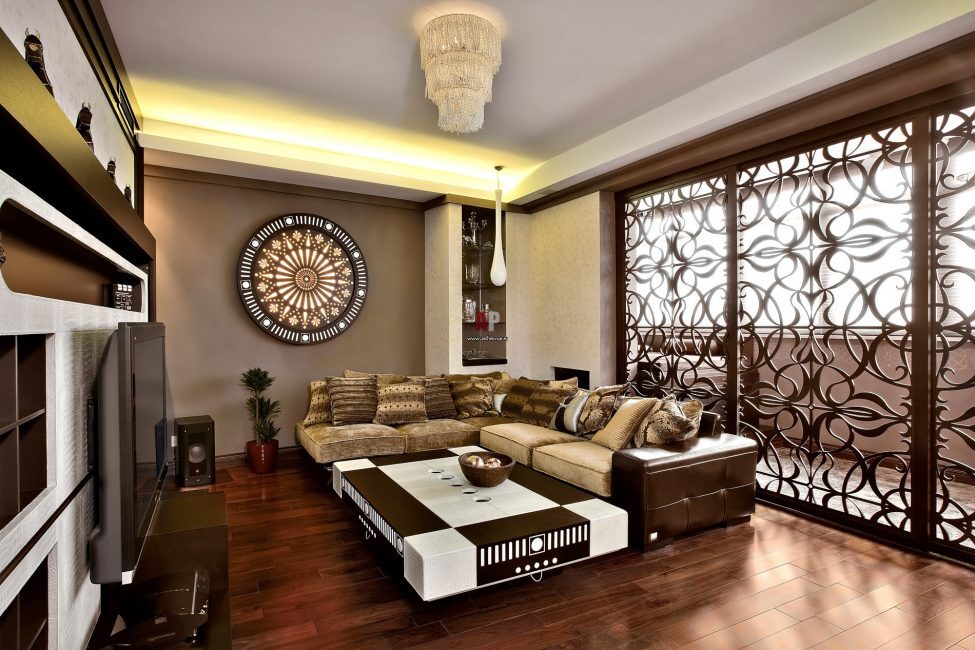
Main trends when choosing furniture
Furniture in Japanese style should be low. Wooden surfaces are smooth and concise. This applies to furniture legs, armrests, headboards, and wall-mounted shelves.

Color Palette
Warm tones and solid surfaces in light shades are what the Japanese have preferred since ancient times.

Popular and actively used shades in Japanese interior design include:
- White
- Beige
- Cream tones
- Sandy.
As for black and red, these colors are never introduced into the interior as primary colors. They are used for accentuation.
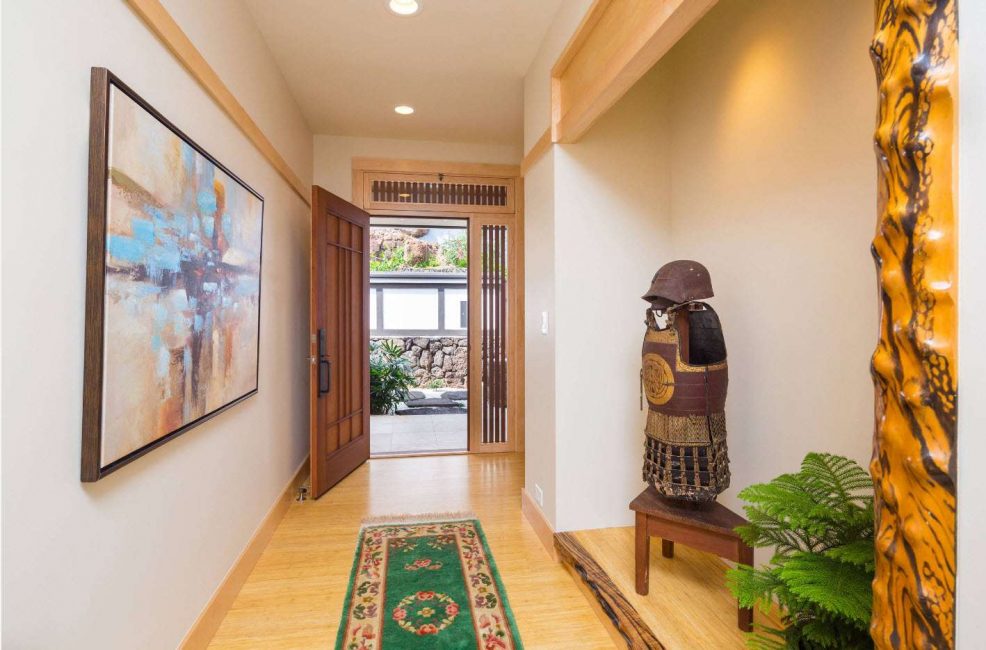
In line with Japanese traditions, the distinctive style is emphasized by three main colors:
- Black
- Red
- White.
There can be no indistinct shades or unclear combinations here. A harmonious Japanese interior is about clarity and order. It also involves combining bright, distinct colors with surfaces made of natural materials.
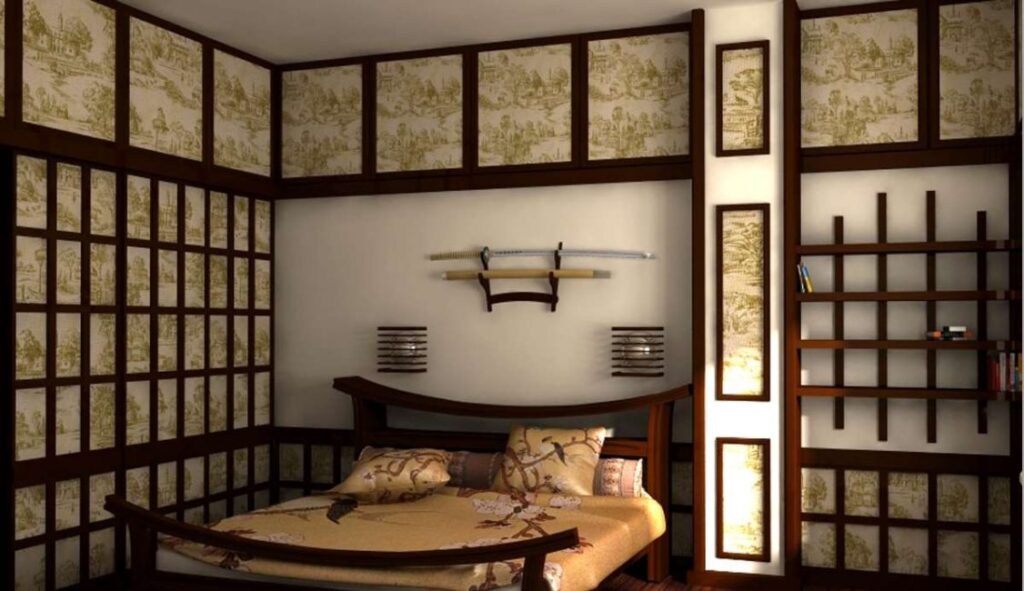
In Japanese interior design, red symbolizes masculinity and strength, while white highlights nature and naturalness. Dark, deep colors are less common in interior decoration.
The basis of Japanese interior design always consists of light, soft shades of beige and milky colors. Occasionally, they may also use:
- Bluish-gray tones
- Shades of blooming cherry blossoms
- Green.
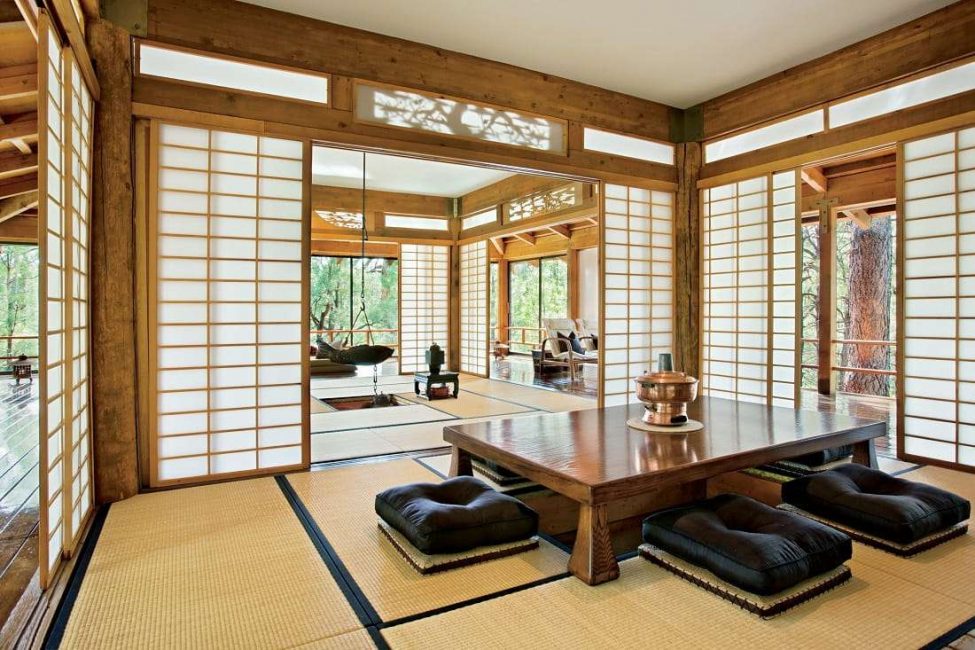
Japanese Style: Environmental Friendliness Comes First
The simplicity and minimalism that are characteristic of Japanese style are based on the use of natural materials. In previous centuries, only easily accessible materials were used for decorating homes.
These include:
- Straw matting
- Bamboo
- Stone tiles
- Reed
- Wood
- Rice paper
- Natural silk.
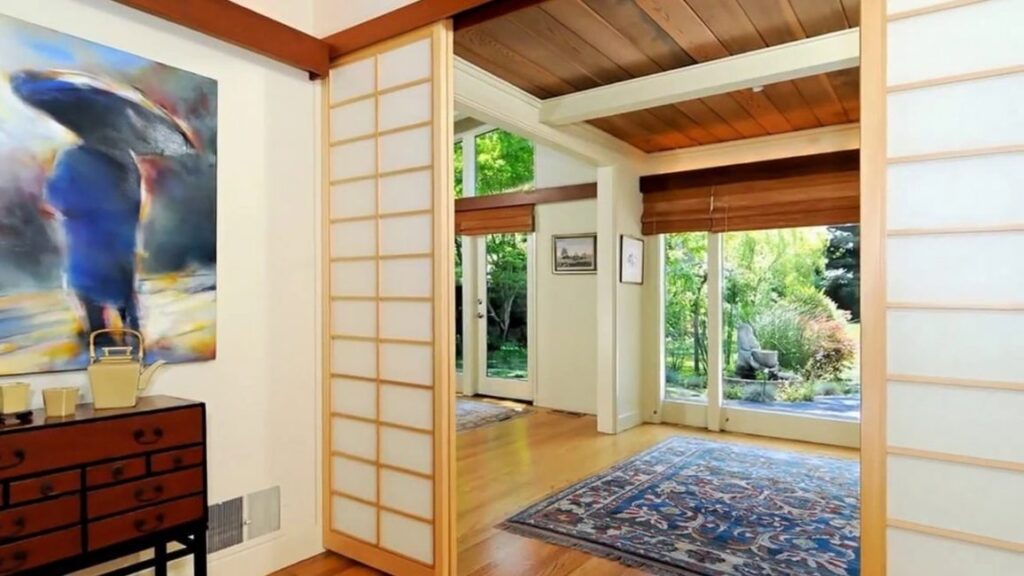
Currently, the rules of decoration are not as strict. However, the use of synthetic materials is also limited. This includes plastic and similar materials.
But artificial materials are not completely prohibited in Japanese interior design.
If there is no possibility to use, for example, natural wood, it can be replaced with high-quality laminate. A similar approach is necessary when replacing natural stone with an imitation, natural silk with fabric that looks very similar to it.

Partitions
Partitions between rooms in the Japanese style add originality to the apartment and emphasize the direction of decoration. They are mobile and lightweight, as they are made of rice paper or bamboo.
At first glance, this strange and impractical approach actually has a historical and practical basis. Frequent earthquakes in the Land of the Rising Sun taught the Japanese to build houses that can easily withstand difficult circumstances. And if necessary, they can be easily replaced.
Currently, blindly following these traditions is not necessary. Manufacturers offer more practical models: Japanese-style sliding doors with prints on the panels.
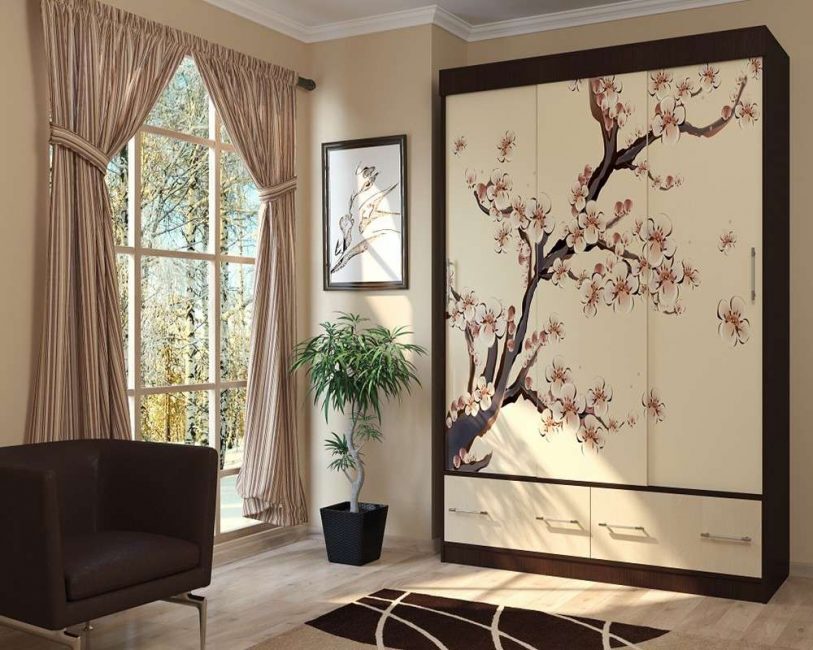
Screens are an optional but very stylish element of modern Japanese design. If you need to separate any area of the room, there is no better replacement for them.
Furniture for Contemplating the Inner World
Do you want to relax and unwind at home, enjoy tranquility and regain strength? Japanese design promotes relaxation from the hustle and bustle of the city, noise, and relationship issues.
The proximity to nature and the earth in the interpretation of Eastern design implies the use of solid furniture made of natural materials. Low-sitting objects should have stable, low, and strong legs with a simple form.
High cabinets cannot be in the interior. And there should not be too much furniture.
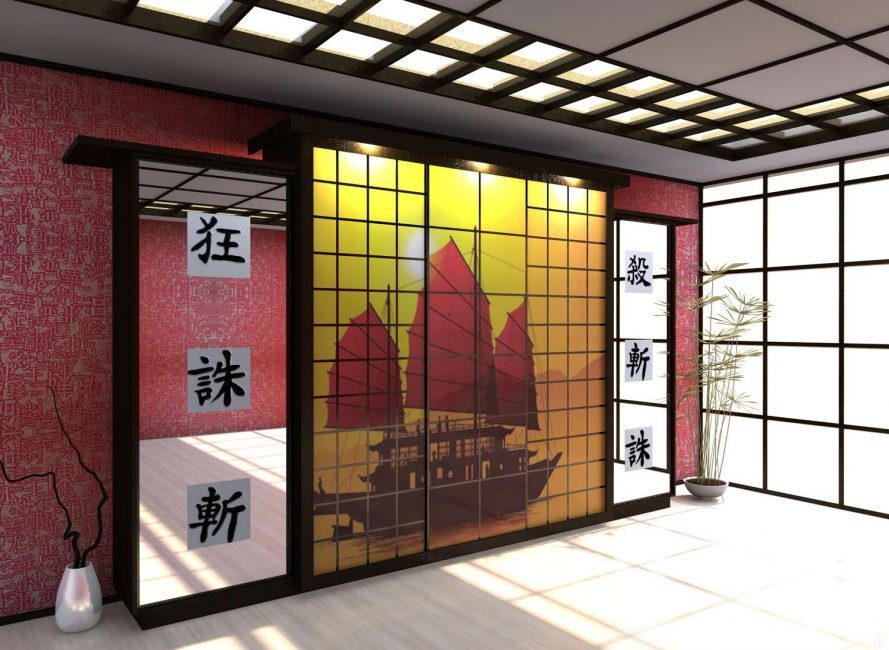
Wood is a typical material for making furniture in Japanese style. Valuable wood species can be replaced with coniferous trees. Even if the furniture is very expensive, it should not “shout” about it. A connoisseur of quality things will always be able to understand that the item is not ordinary. Another characteristic feature is the absence of carving on wooden surfaces and inserts made of plastic.
There are two ways to purchase interior items for decorating an apartment in Japanese style:
- Authentic Japanese items with a history.
- Collections presented on the market today.
Furniture fittings should not be flashy either. For example, forged elements made very neatly are acceptable as a means of emphasizing the texture of the main material.
Antique items can be the highlight of the interior in Japanese style.
What interior items are indispensable in a strict Japanese design?
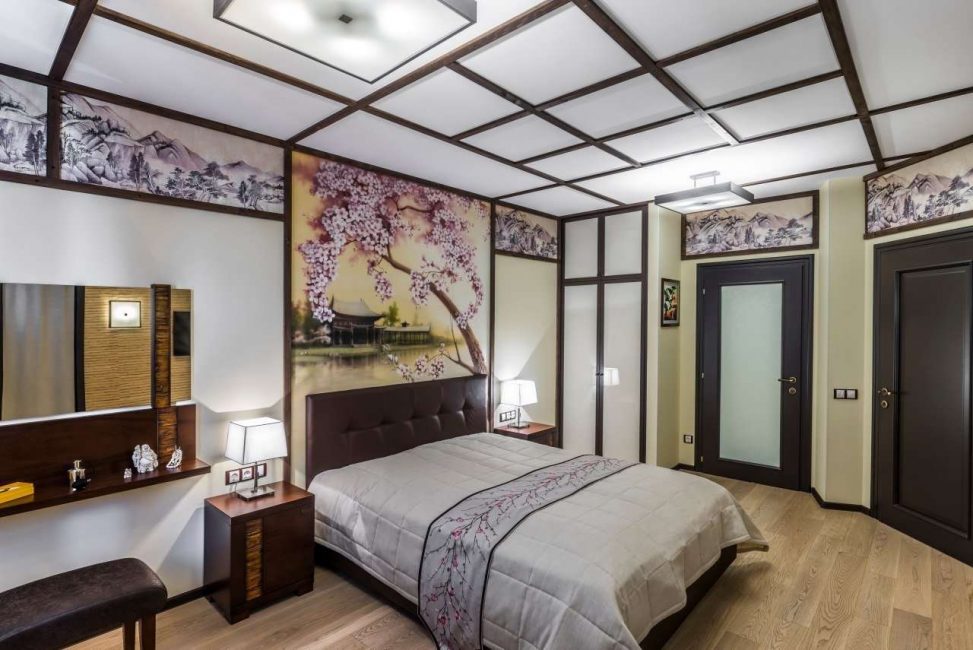
Among them should be:
- low-legged beds (which can be replaced with mattresses);
- low coffee tables for traditional tea ceremonies;
- special zabuton or cushions near the table;
- cabinets with sliding doors.
Engawa or traditional window?
Initially, Japanese houses were equipped with special eaves, which are called “engawa”. Such structures protected against rainwater and shaded from too bright sunlight.
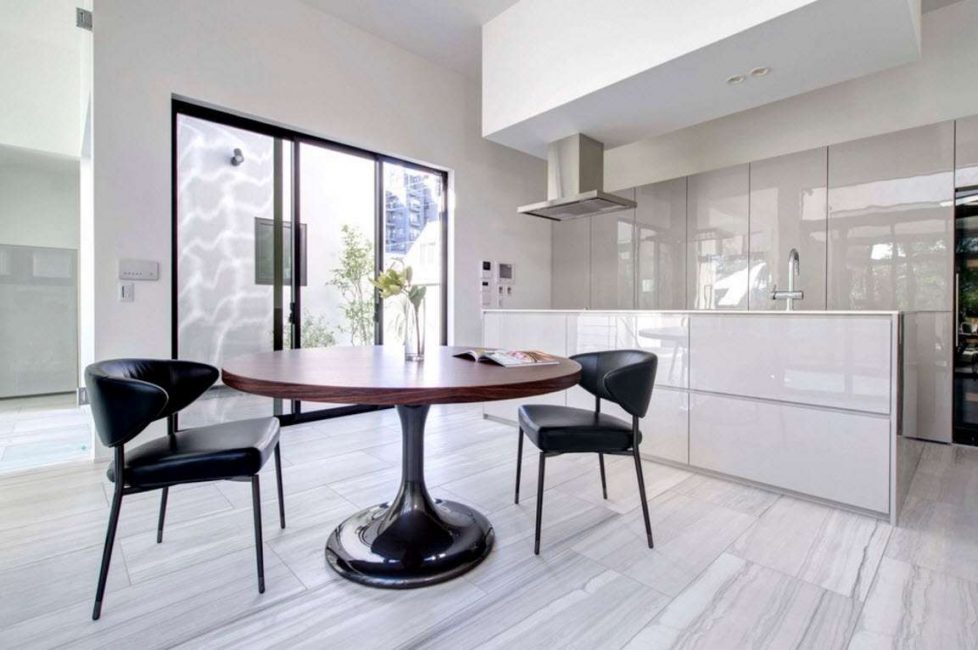
Traditionally, there should be many windows in Eastern-style interiors. Rectangular pieces of fabric that slide to the sides are used as curtains in homes with a Japanese-style interior. They can be equipped with an electric drive for control.
Prints on curtain fabrics should precisely follow the canons of Japanese style:
- cherry blossom branches;
- bamboo shoots;
- bright birds;
- Japanese landscapes;
- hieroglyphs.
Roller and Roman shades are used for shading. The more even and concise the curtains, the more precisely they correspond to the style.
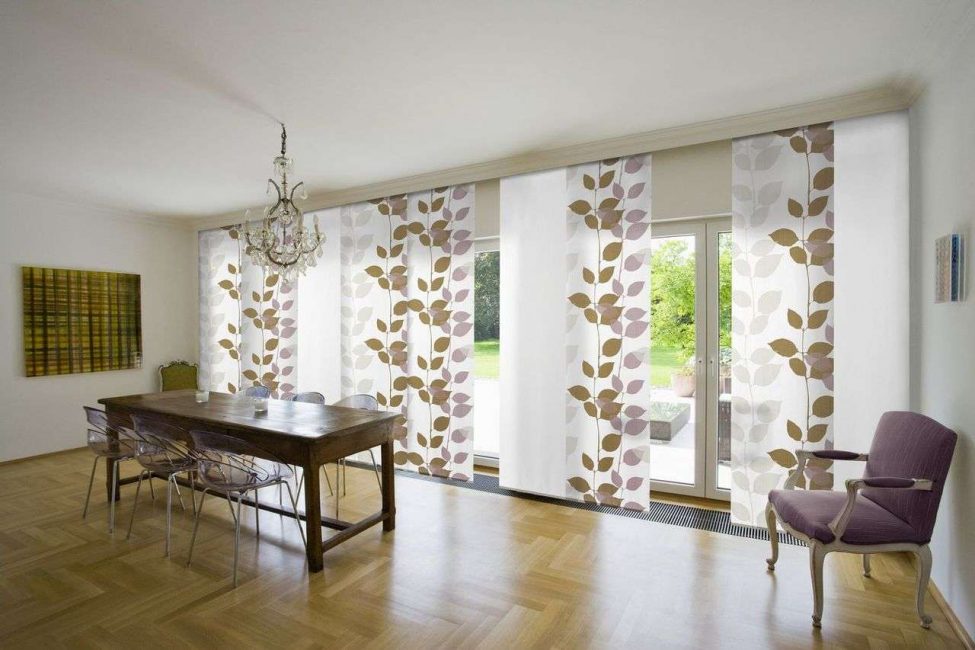
When decorating in the Japanese style, curtain models with ruffles, draperies, and complex accessories are not used.
Walls
When decorating walls in a Japanese interior, as with other surfaces, it is important to follow the rule of using natural materials. A combination of several materials looks impressive. What should you choose?
The following materials are suitable:
stone;
plaster;
rice paper wallpaper;
sisal;
rattan;
wood.
Furniture in Japanese interior design is very minimal and low. The quantity and placement of furniture should be taken into account when selecting materials for walls. There shouldn’t be too many paintings on the walls.
Wallpaper
Eastern motifs on wallpaper in the interior affect the perception of the entire room. They serve as a background for furniture, create necessary accents, and emphasize authenticity.
Wallpaper (and photo wallpaper) are most often used in bedroom decoration. It is preferable to choose a light and neutral background in pastel shades. To emphasize the originality of the design, complementary colors are added.
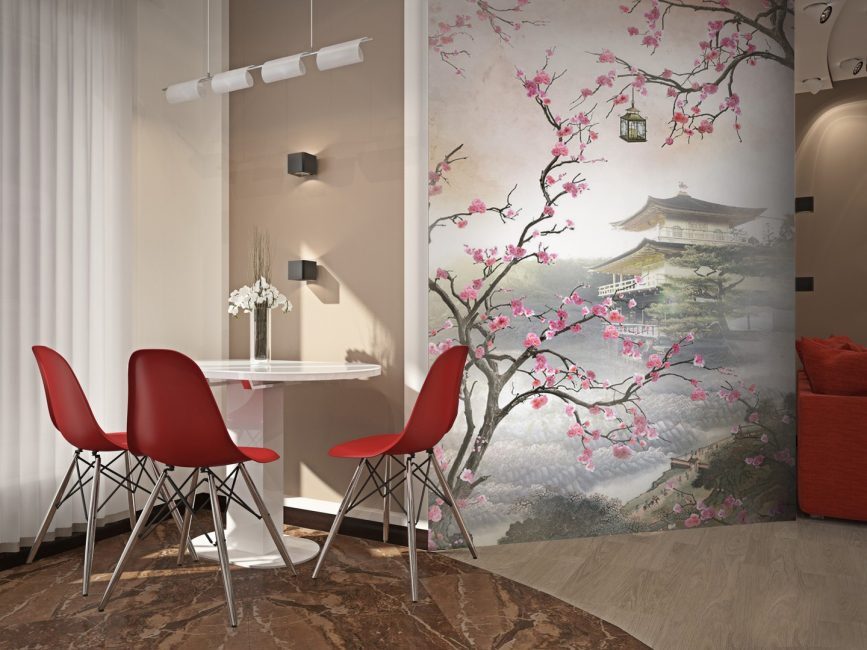
Wallpaper can be combined with other natural materials such as wood and bamboo. If solid color wallpaper is preferred, one of the walls can be decorated with a photo wallpaper depicting, for example, cherry blossom branches. Such wallpaper can create the effect of a photograph, a view of Mount Fuji, or other typical Japanese landscapes.
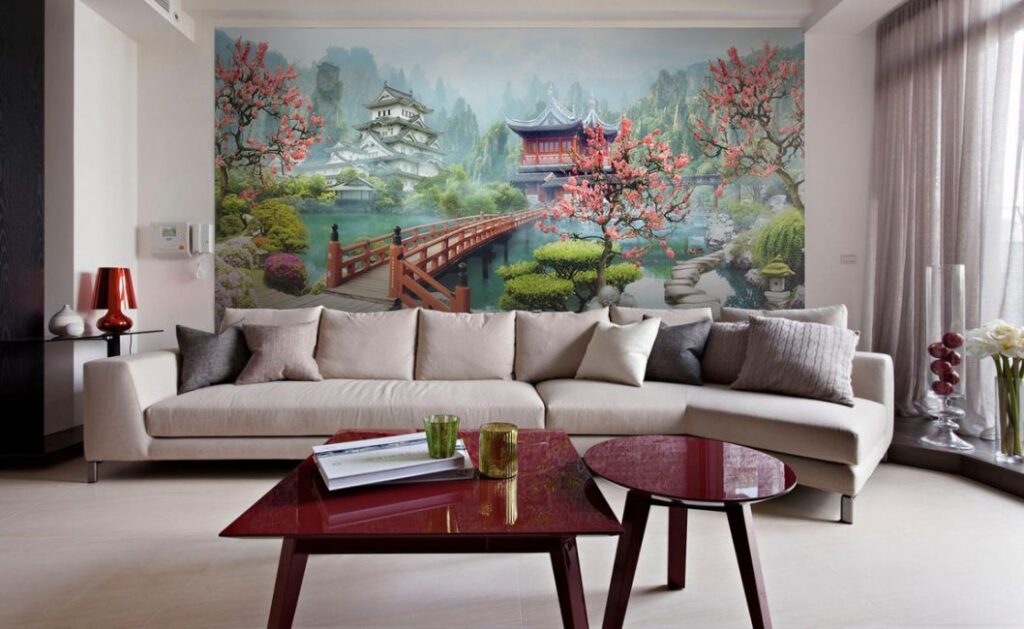
National motifs on the walls emphasize the style of the interior, adding notes of uniqueness and originality. This allows for the creation of an interior that is unlike any other.
Wallpaper made in Japan
It’s worth mentioning the wallpapers made in Japan. Made from natural materials, they pose no threat to health. The materials used include bamboo and jute.
Produced under strict quality control, these wallpapers are highly durable, elastic, and have a long service life.
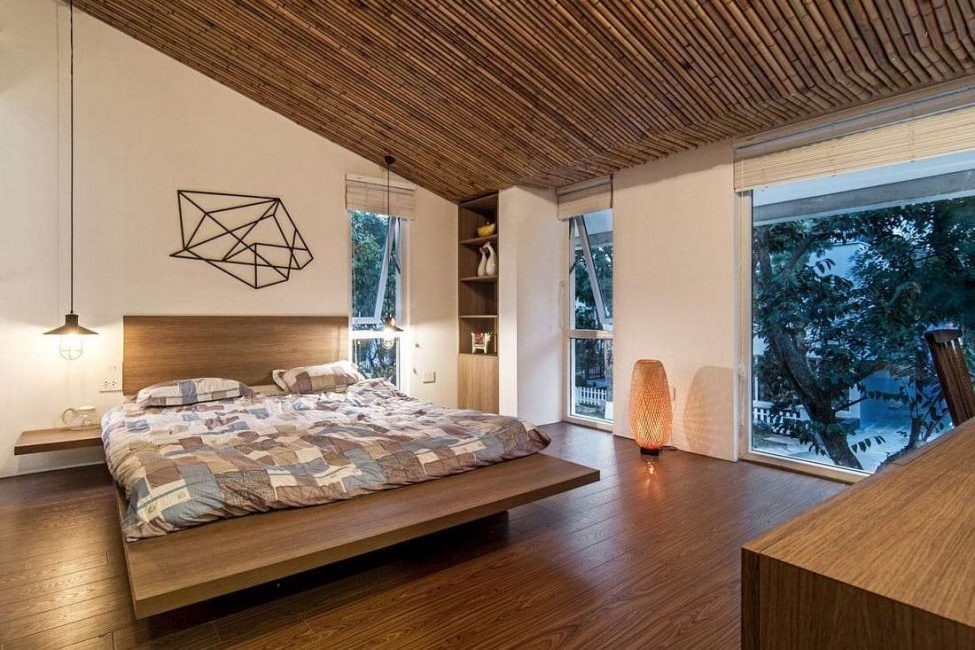
In addition to aesthetics, such wallpaper also have other useful properties:
- block possible formaldehyde emissions from walls;
- eliminate cigarette smoke odor;
- versatile in design;
- fire-resistant;
- provide good sound insulation;
- conceal wall imperfections;
- environmentally friendly;
- durable;
- have anti-fungal properties.
The cost of such finishing material is relatively high due to the use of natural materials and the complexity of the technological process. In addition, most collections are formed based on manual methods.

Flooring: which covering is better?
When it comes to flooring, in the past, the following materials were commonly used in Japanese interiors:
- Stone tiles
- Wood
- Pebbles
Comfort and convenience can be added to the flooring by using rugs made of various materials such as fibers, straw, or other materials.
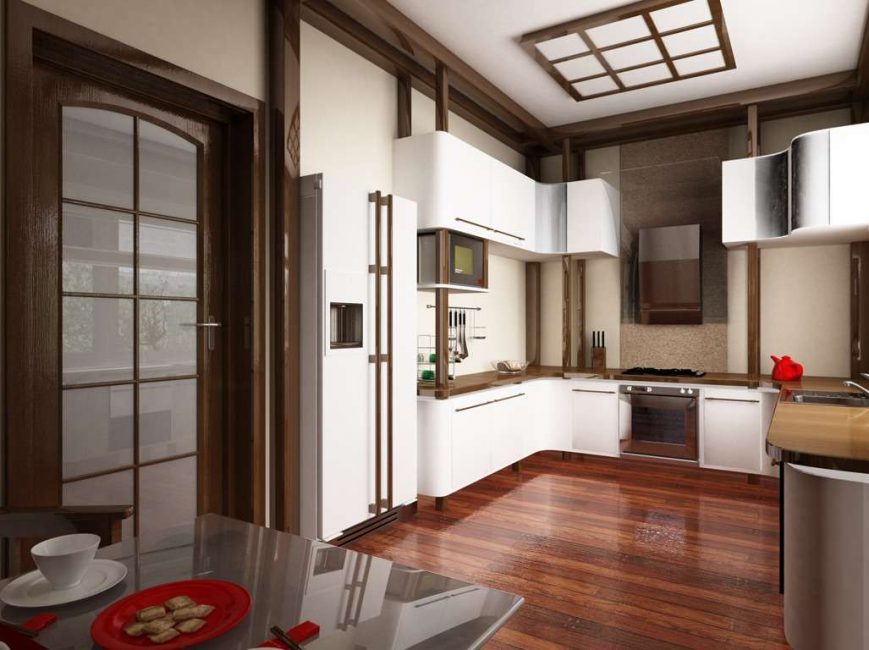
When it comes to flooring, there are now more options available:
- ceramic tiles;
- hardwood flooring;
- laminate;
- natural wood;
- poured flooring.
When using imitations instead of real wood, the texture should be emphasized and highlighted. And no matter what type of flooring is chosen, it should create a matte surface.
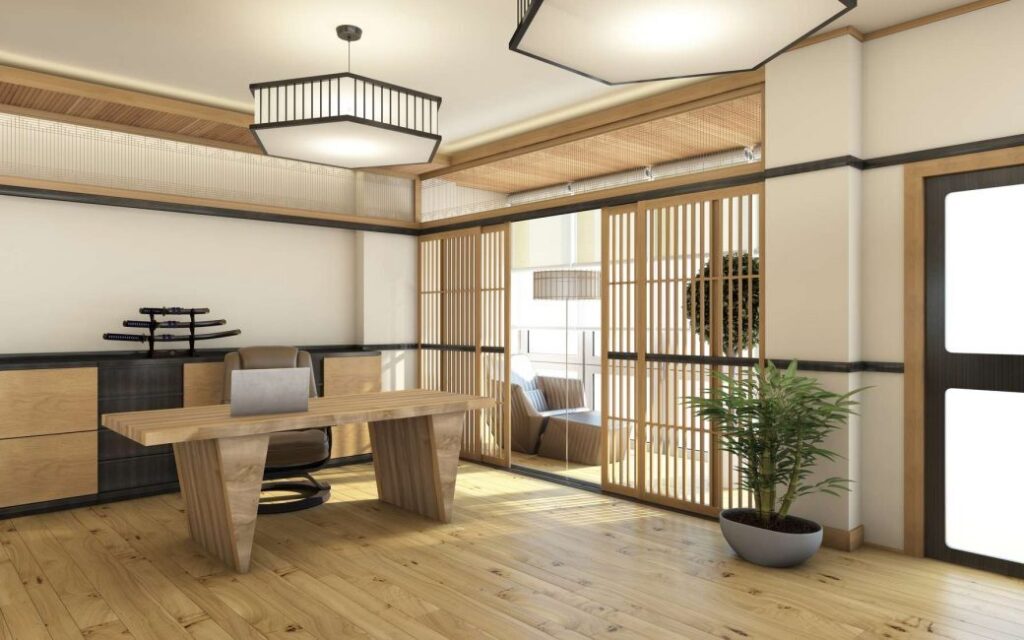
Using finishes can be used for zoning in Japanese-style interiors, as well as multi-level constructions.
Ceiling: form and content
The shape of the ceiling in Japanese style should correspond to the overall direction. A clear shape (triangle, rectangle) is emphasized by color, material, and design.
Finishing in this case plays an important role. Wooden beams, painting, and panels can be actively used.
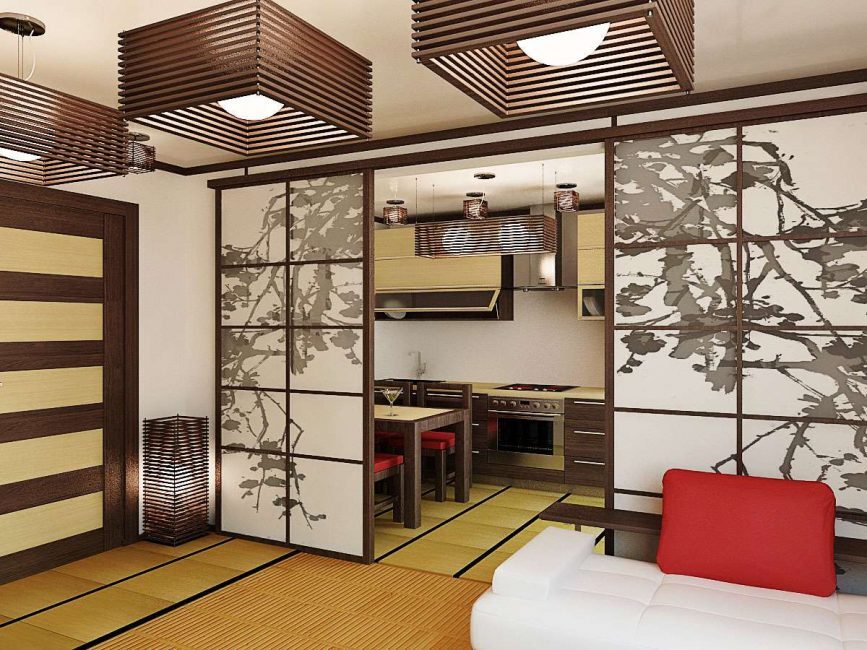
With the help of ceiling decoration, it is possible to organically highlight certain areas. For this, a multi-level organization or decoration with a different color can be applied.
Fabric, creating comfort
Textiles in the design should follow the same basic rule: naturalness and simplicity. In Japanese interiors, it is needed for windows, seating areas near the table, relaxation areas, in the bedroom, for curtains.
The most preferred materials are:
silk;
linen;
cotton;
blended fabrics.
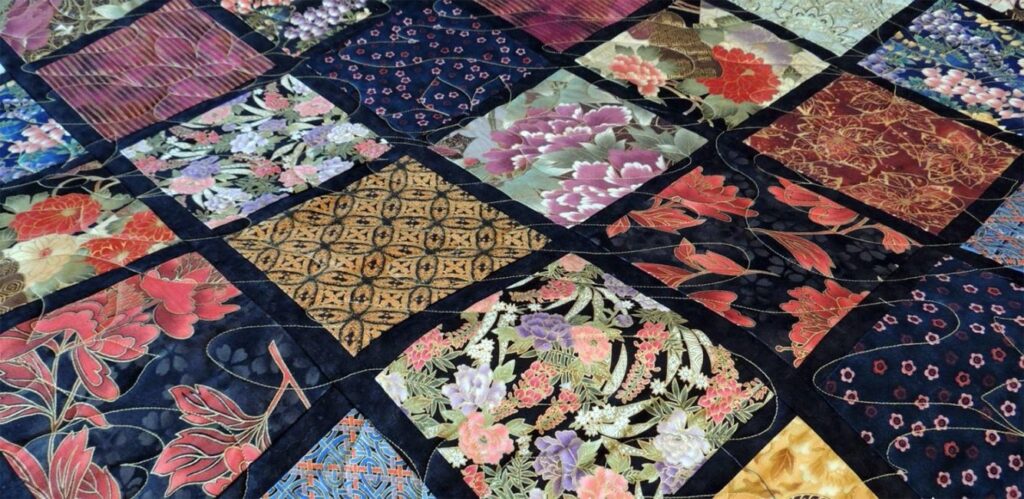
Prints can depict:
- A blossoming cherry tree branch
- Calligraphy
- Animals
Accessories: placing accents
The Japanese interior is a harmoniously organized space. The room design should be balanced and thought out. All decorative elements should be contrasting with the main background, but at the same time carefully considered.
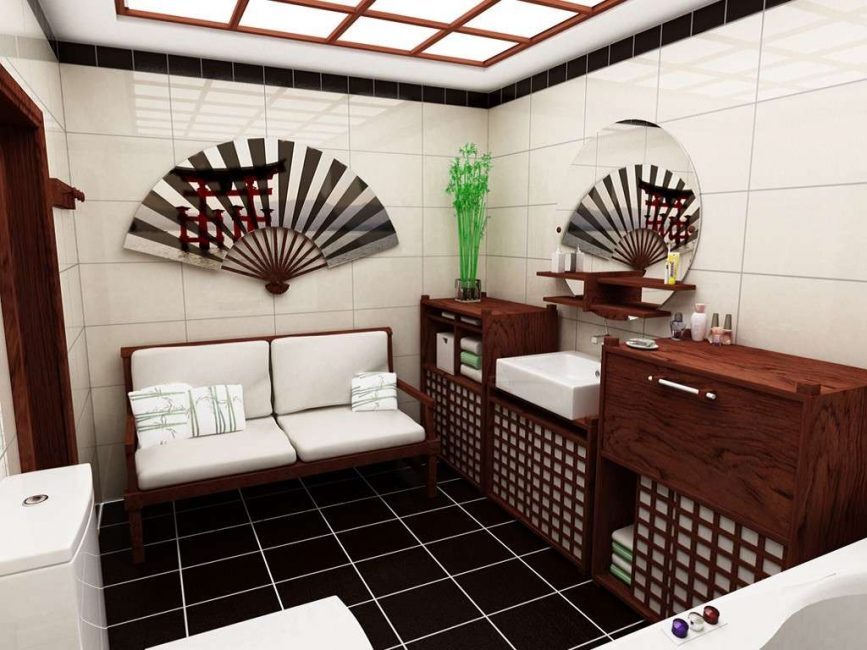
Accents in Japanese style can be created using elements such as:
- porcelain dishes;
- paintings;
- blooming orchids;
- Japanese lanterns;
- ikebana;
- traditional fans;
- bonsai trees;
- stylish screens;
- decorative pillows;
- small boxes;
- Buddha statues.

Lighting that emphasizes Eastern flavor
Lighting is given special attention in Japanese homes. The light should be diffuse and come from multiple sources in each room. Lampshades made of bamboo or thin rice paper can be selected for the light fixtures.
By planning the placement of light sources, you can change the impression of the room, highlighting the necessary areas. Light accents are especially important in studio apartments that do not have walls.

Interiors of rooms
Let’s take a closer look at the interior design of each room. What and how to use it best, and what you really don’t need.
Bedroom
A rest room in the Japanese style is an organic and original solution. The selection of materials and furniture items begins with determining the dominant color. In addition to it, several harmoniously matching shades can be selected.
If the bedroom is very small, it is best to make the floor white (for example, from bleached wood). This technique will visually expand the space.
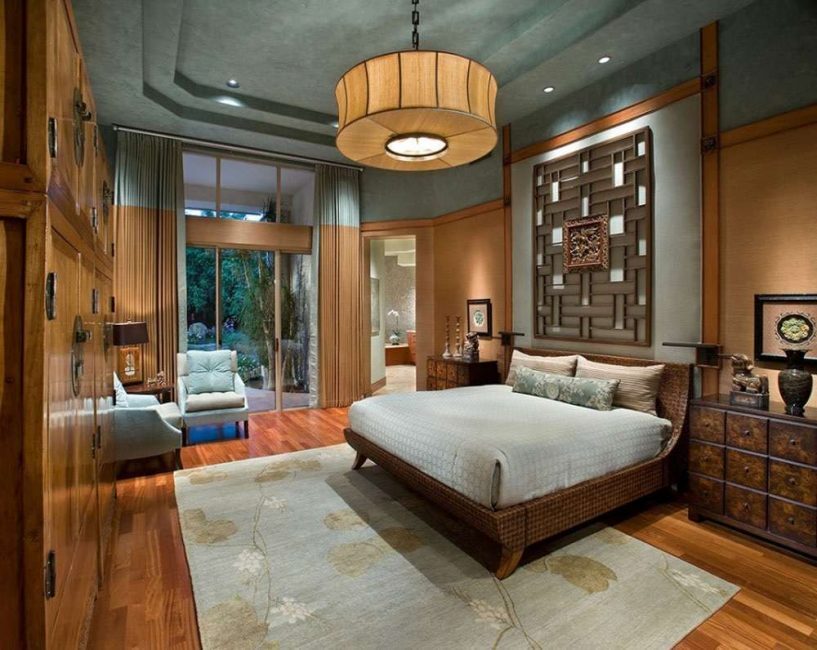
For the bedroom, the following colors would be suitable:
- Gray
- Cream
- White
- Black (less common)
Soft, diffused lighting can be achieved by using lampshades made of paper, matte glass, or fabric.
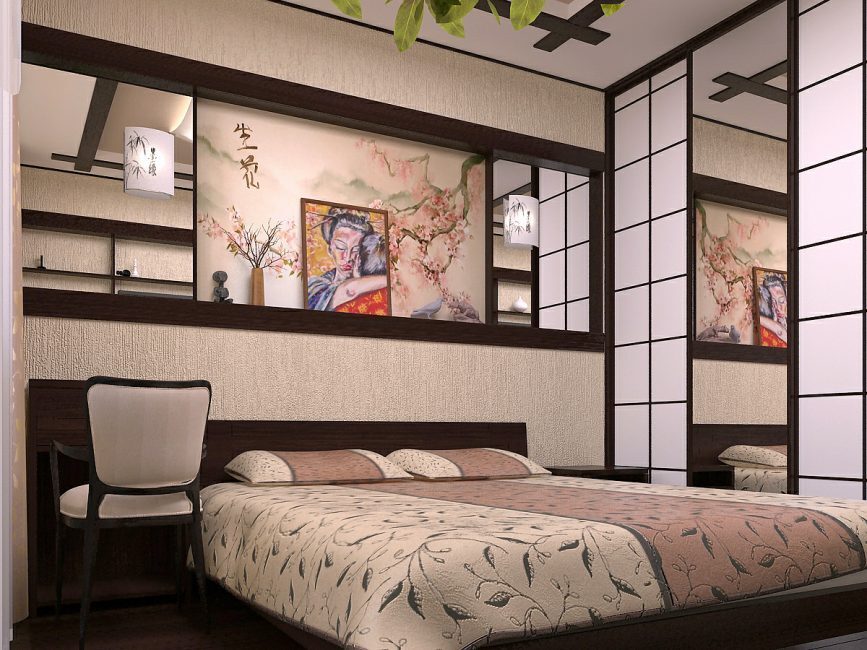
In decorating a bedroom, the following recommendations can be followed:
- Use of wallpaper (including bamboo) and ethnic prints.
- Wooden panels.
- Plain fabrics on the walls.
- Minimalist bedside tables.
- Only necessary furniture placement. Nothing extra.
- Built-in closet with sliding doors.
- Hanging curtains, the shape of which is emphasized by weights at the bottom and top.
- Suspended ceiling, with possible inserts made of frosted glass, creating a beautiful “moonlit sky” effect.
- Built-in lighting.
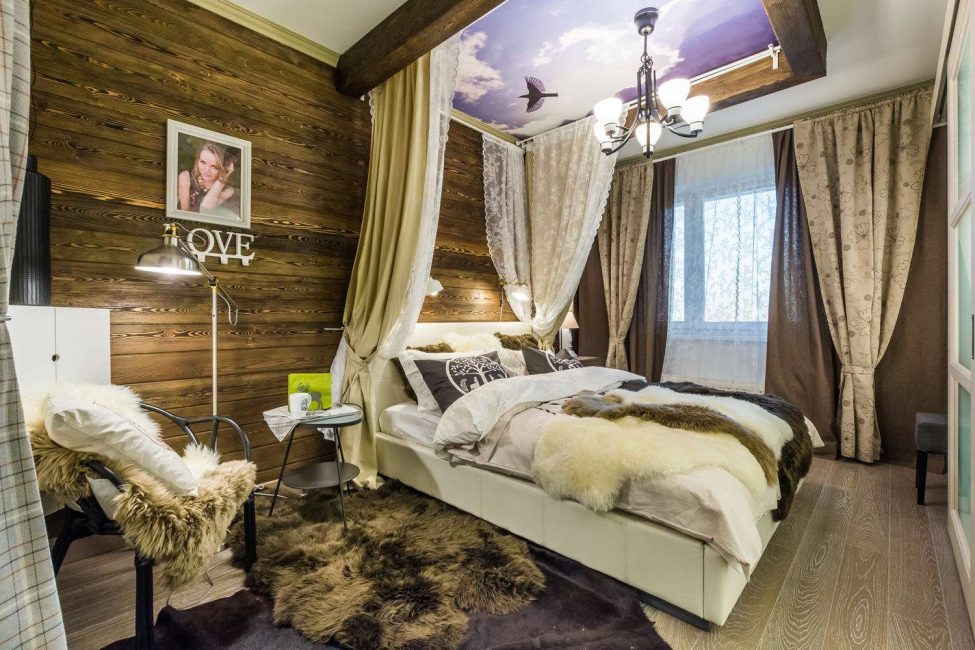
Expressiveness and conciseness are given to the room with accessories. There shouldn’t be too many of them. They can be paintings, fans on the walls, bonsai in pots, dolls in national costumes. A bright accent can be made on the bed decoration, using a cover with hieroglyphs or red pillows.
If the bedroom is not a separate room, it can be highlighted with the use of screens.
Children’s room
Japanese style prefers light colors, which is a plus when decorating a child’s room. Natural shades and natural materials allow not only to emphasize the style, but also to create an ecological and healthy interior.
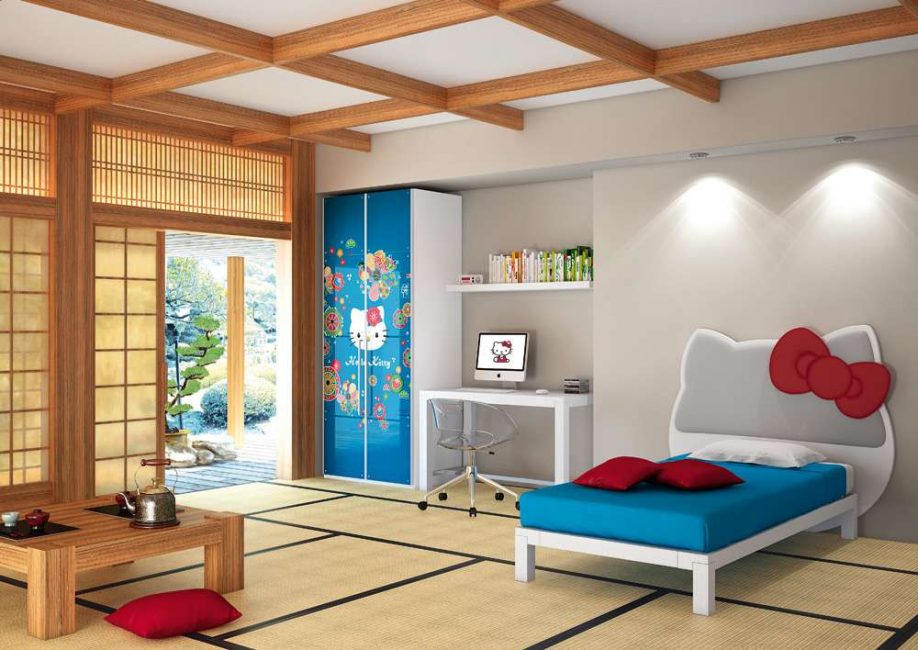
Monochrome walls in a calm color scheme can be complemented with photo wallpapers depicting characters from Japanese fairy tales or views of East Asian nature. For girls, prints with blooming cherry blossoms, weaving roses, and delicate flowers can be selected.
Furniture selection should be based on the following principles:
- Comfortable and convenient bed, placed preferably in the central part of the room;
- A functional and well-lit workspace;
- A partition screen to separate the resting area from the play area;
- A wardrobe with sliding doors, which can be organized as built-in;
- Shelves – necessarily wooden, but light enough.

Choosing accessories depends on the gender and age of the child. Preference should be given to those made of natural materials that emphasize the style, such as national dolls and figurines.
Living Room
This room is the central space in the house, intended not only for relaxation and communication among family members, but also for meetings with friends and business partners. Therefore, all the specifics should be taken into account when designing it. A neat, bright space with a minimal set of items and an unusual style will not leave guests indifferent.
The living room can have a greater presence of black color than in other rooms. The saturated dark color looks solid and adds significance. But even in the living room, there should not be too much dark color.
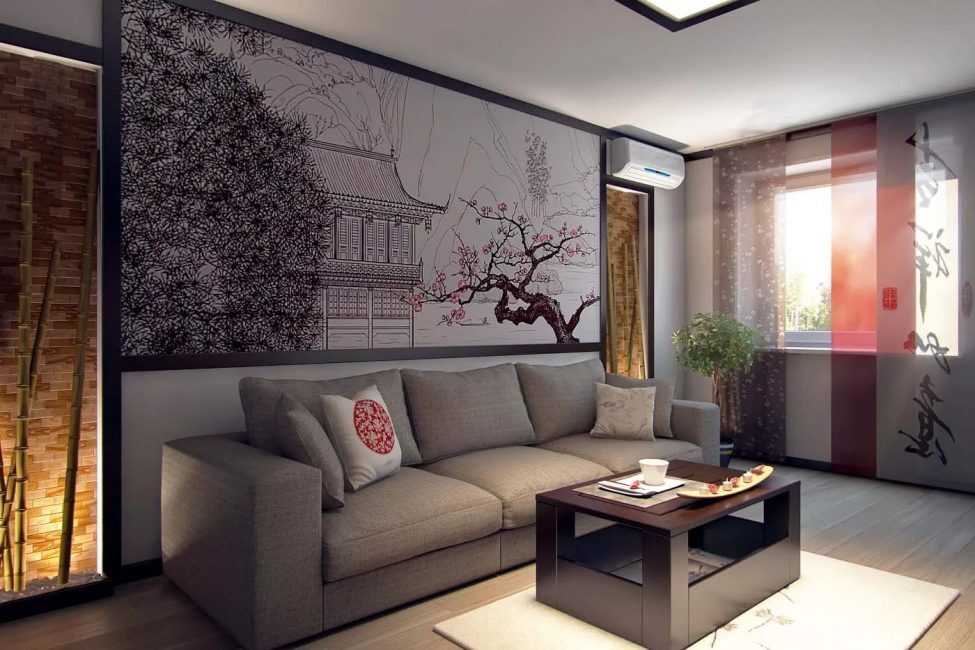
The predominant colors are still natural light shades:
- beige tones;
- white;
- ivory;
- natural wood shades;
- gray.
To emphasize respectability, it is preferable to choose natural materials.
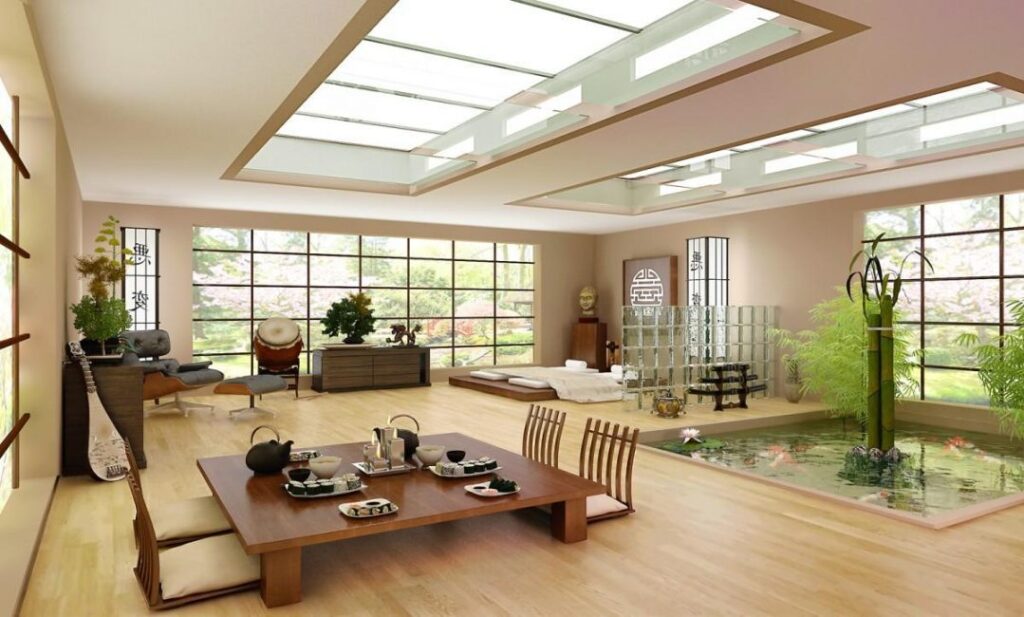
In a studio apartment, you can establish the living room area on a low podium. Use color (for the floor, walls, ceiling, and furniture) and lighting to add emphasis.
Stick to a minimal set of furniture, including only the most necessary items. Incorporate household appliances into the interior in a way that allows them to blend in, instead of standing out. If the living room includes a workplace, consider separating it with a Japanese-style screen.
Replace high comfortable armchairs and bulky sofas with simpler and more ascetic forms. Though this may initially seem uncomfortable, it fits with the minimalist style. Consider built-in storage systems with sliding doors. If you own a library, you might want to organize book storage in artificial niches built directly into the walls.

If there is a lot of technology that disrupts the overall harmonious picture, it can be separated by a screen.
The decor of the living room should be restrained and strict. Family photographs and souvenirs from vacation spots cannot be displayed here. Neutrality is one of the main requirements. To decorate the room, you can use pictures on the walls, antique vases, and bamboo.
Bathroom
The laconicism inherent in the entire design should be reflected in the design of the bathroom. The traditional bath is wooden, carved, and processed using a special technology.
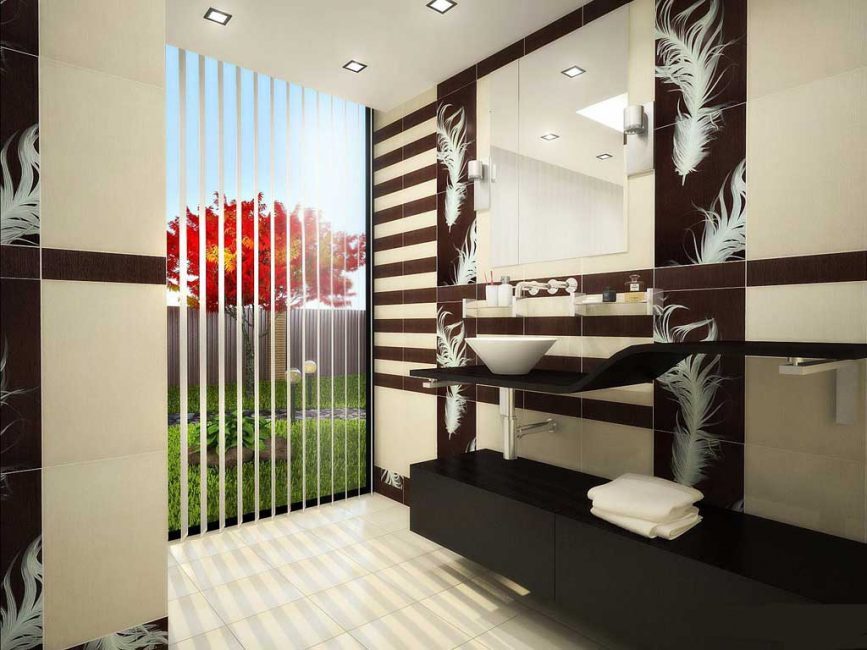
Contemporary trends allow for a compromise and the use of regular bathtubs, but installed on a wooden podium or with stone decor. Washbasins are smooth and oval-shaped, with a wooden countertop beneath them.
When it comes to showers, the same minimalism is observed:
- simple glass partitions;
- a drain hole in the floor;
- simple organization of taps and showerhead.
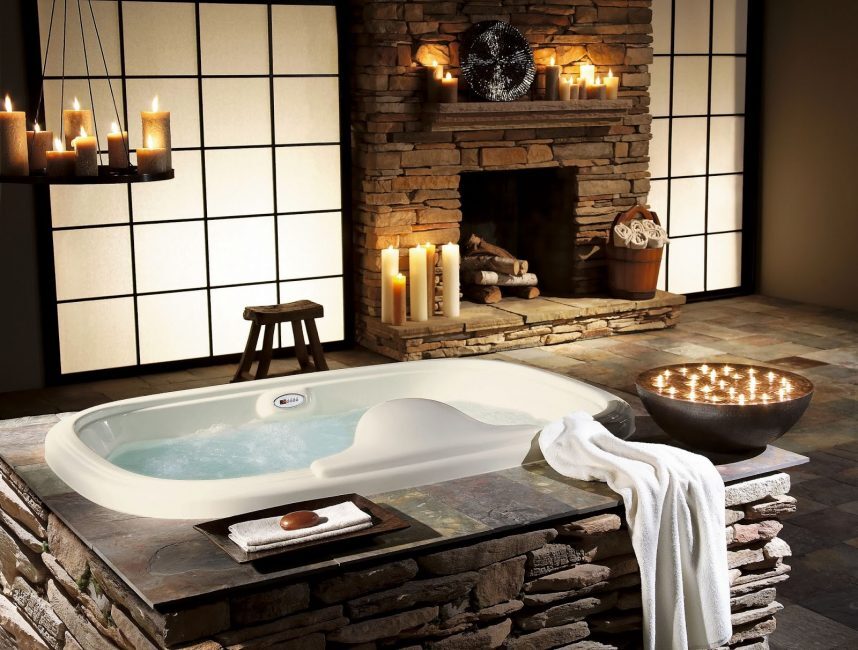
In the bathroom, it is quite acceptable to use photo wallpapers with images of thermal springs, bamboo, sakura, landscapes typical of Japan. It is only necessary to take into account that such wallpapers should be moisture-resistant and designed for gluing in rooms with high humidity.
Entrance hall
The first impression of the apartment begins to form in the hallway. The color scheme should be pleasing to the eye and natural. This includes a wide range of brown shades, gray, and bright colors as accents. The organization of a small space in a Japanese style requires the compactness of the items used. For decor, a floor vase, a picture in a simple frame, or an image of hieroglyphs will be suitable.
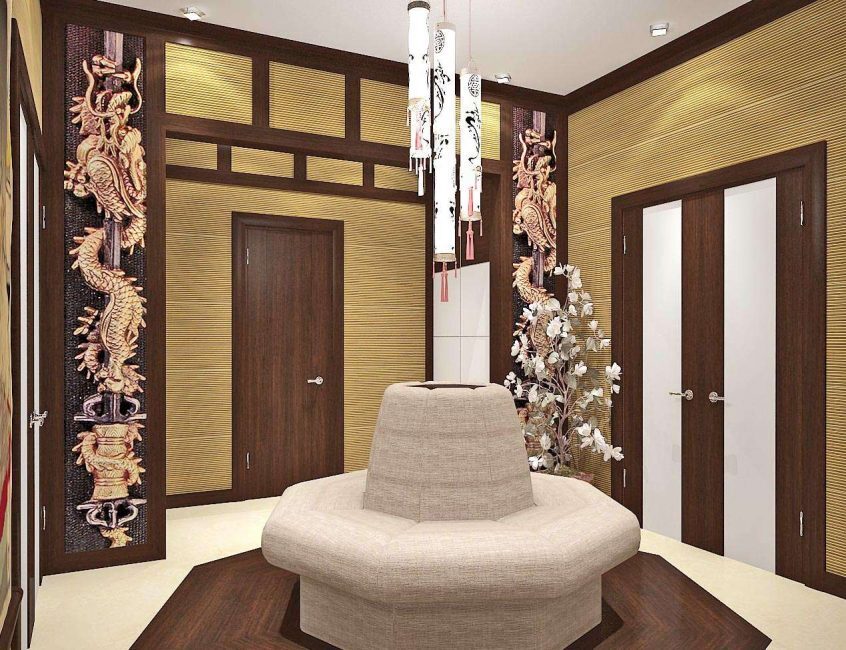
Keep the entryway uncluttered. Make sure the use of free space aligns with the overall style and functionality. You can organize storage with a wardrobe closet, but ensure it’s not bulky. Aim for a neutral facade or choose one with decor depicting Japanese nature.
Opt for modest wooden or bamboo benches instead of plush poufs or graceful benches. This kind of furniture can serve as a standalone decoration for the entryway. If you prefer soft upholstery, consider using linen, cotton, silk, or suede.
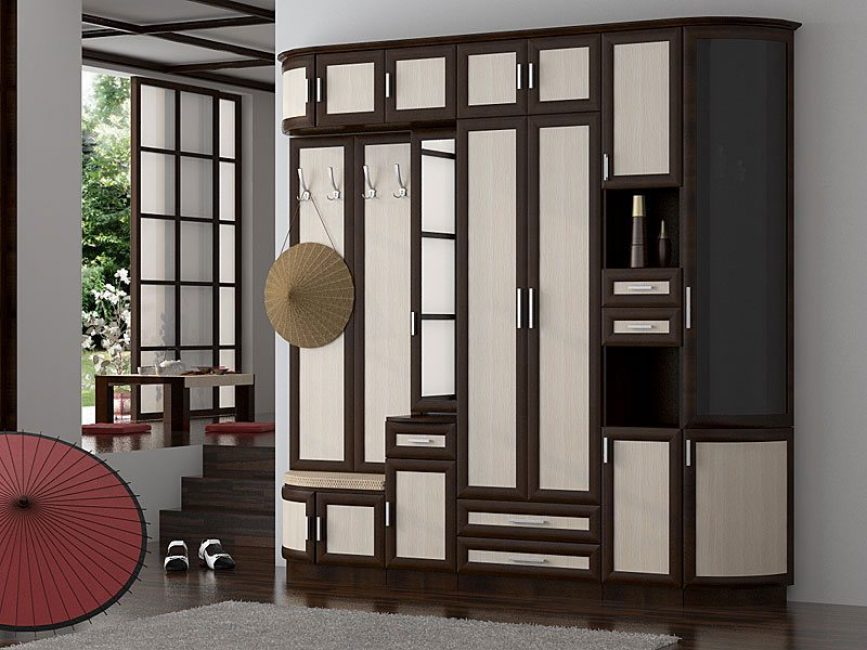
For flooring in the Japanese style, wood or high-quality laminate can be used. A bamboo base is also interesting and unusual in this case.
The hallway should have good lighting. This can be achieved with a large but lightweight fixture that complements the interior. The glass shade is often decorated with a Japanese-style pattern. Lighting fixtures should also have the ability to adjust the intensity of the light.
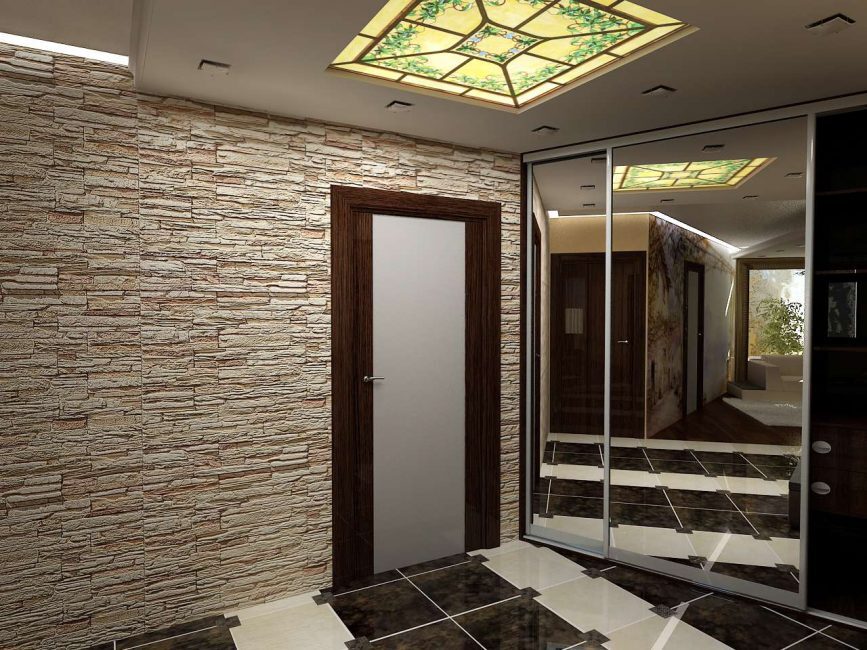
Kitchen
Designing a kitchen in a Japanese style requires wooden furniture and clear geometric shapes. The furniture set should have simple fronts without decorations. Only inlays of matte glass are permissible. It is preferable to choose concealed handles.
The selection of the dining table is based on the size of the room. If there is enough space, the table is placed in the center of the room, preferring a fairly massive model.
If there is a lack of free space, a lighter structure can be used. The chairs should be sturdy and have a streamlined shape.
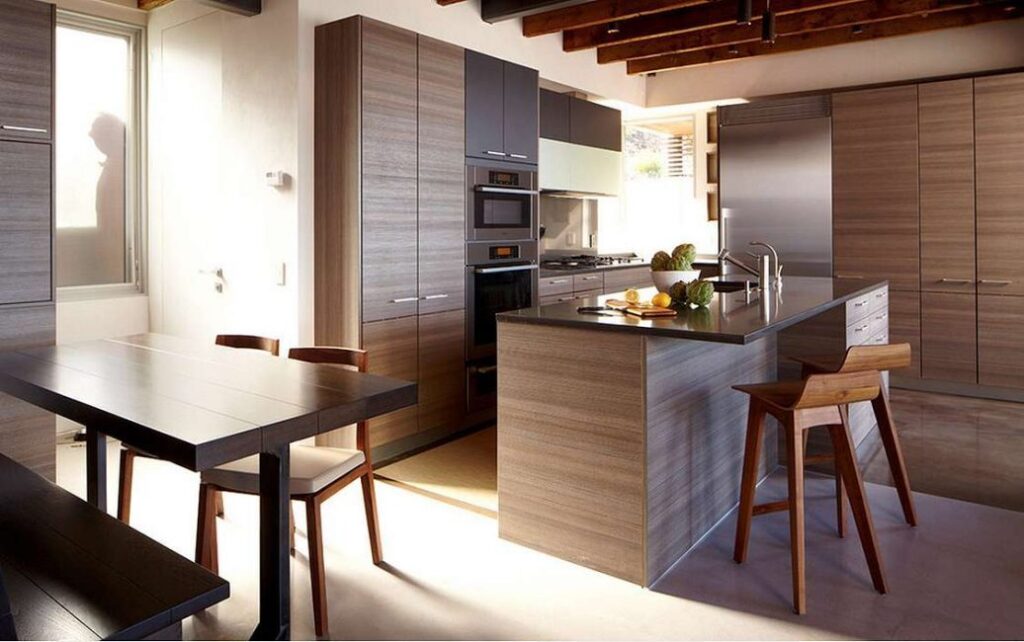
The lighting in the kitchen should be sufficient but diffuse, with simple-shaped light fixtures. In addition to matte glass, the following materials can be used to make lampshades in the Japanese style:
- rice paper;
- jute;
- wood;
- twigs;
- straw.
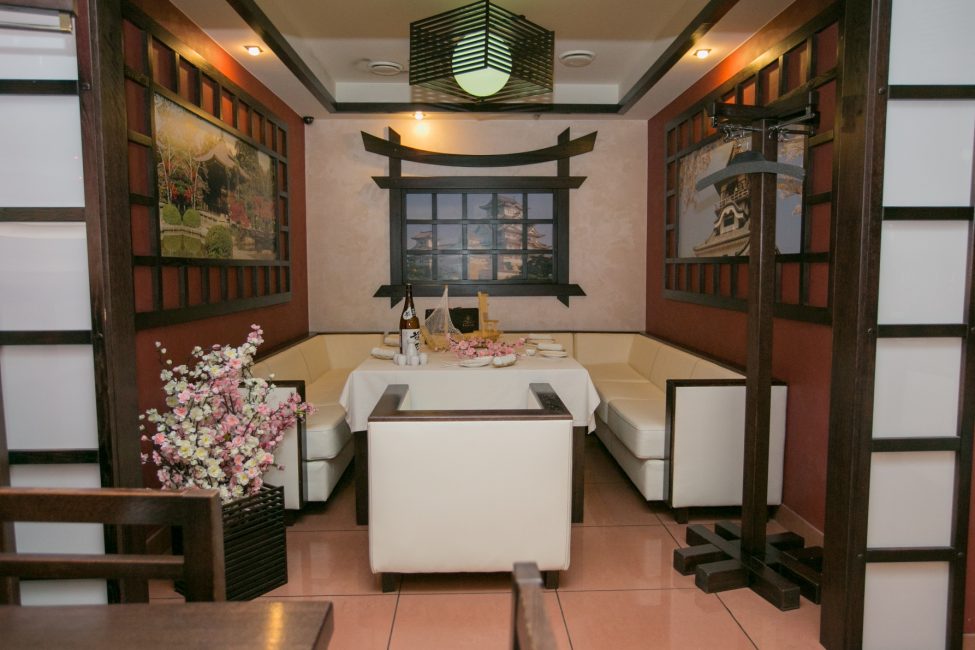
The kitchen decor is minimal. For instance, there’s a scroll with hieroglyphs on the wall, vases in a niche, an ikebana arrangement, and an ethnic engraving. Living plants are an additional decoration in a Japanese home, such as bamboo, orchids, and bonsai.
Conclusions
Kitchen utensils placed on stands and open shelves should match the Eastern ambiance. Ideally, all items should be selected in the Japanese style, harmonizing with each other and with the overall design.

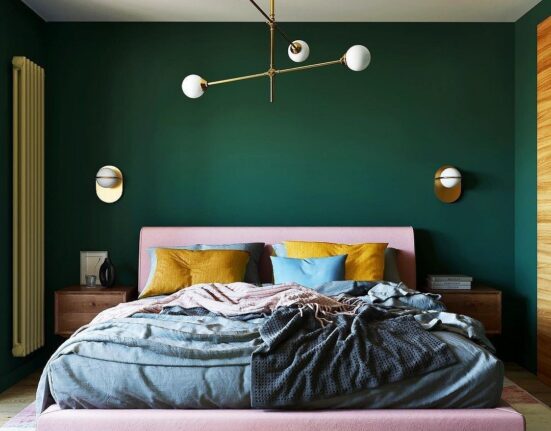

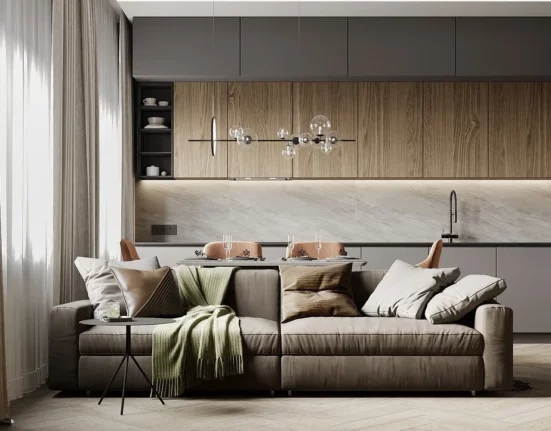
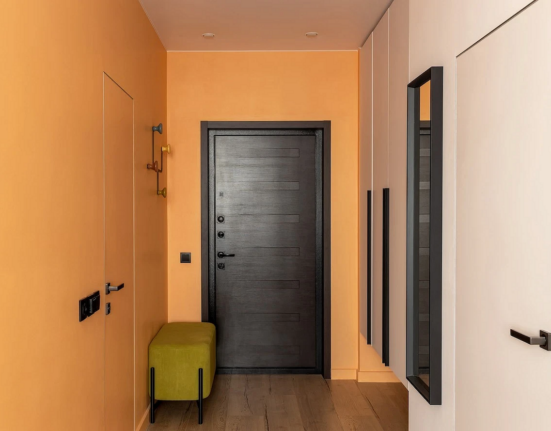

Leave feedback about this